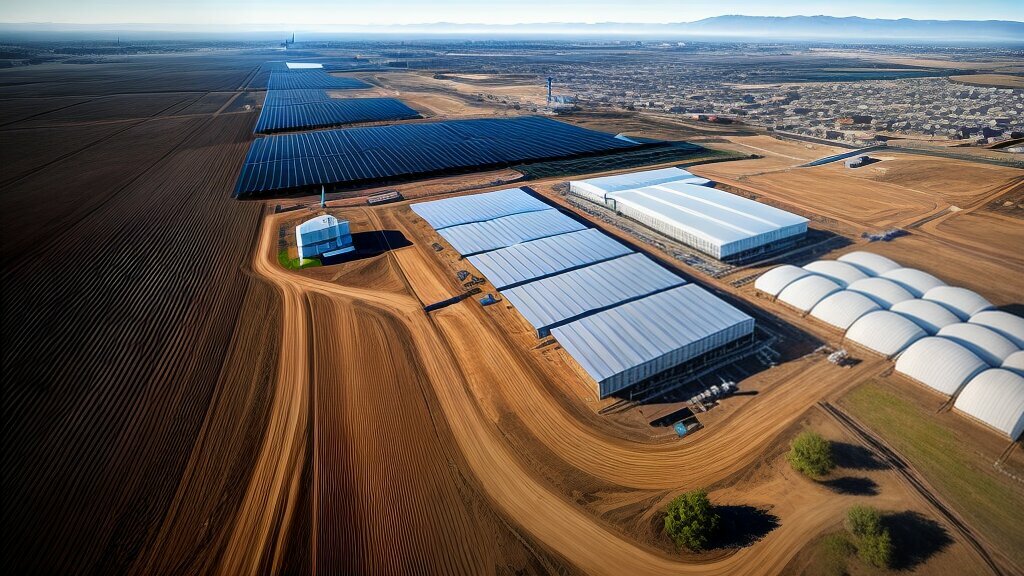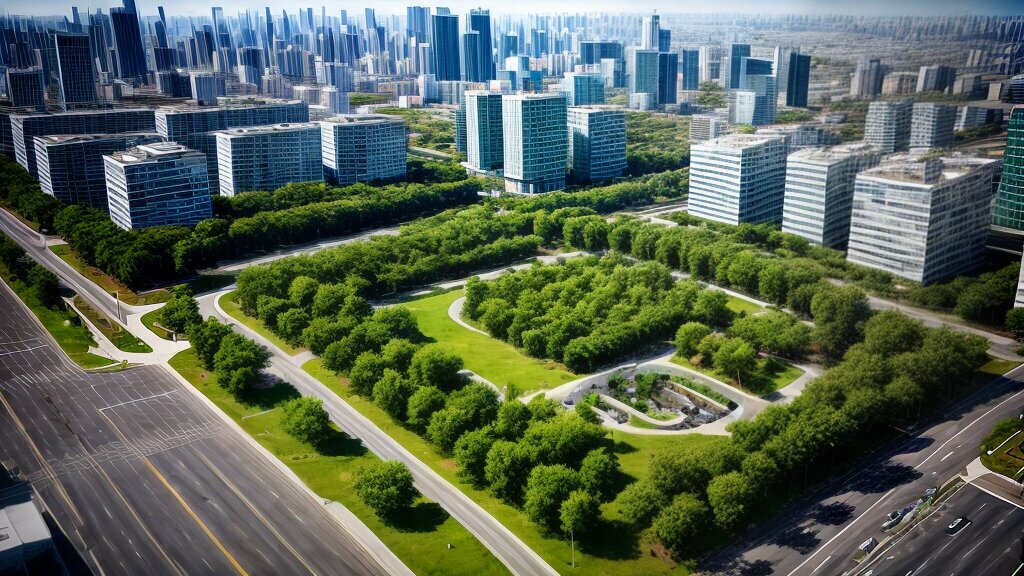Reducing Carbon Footprint in Construction: Strategies for Low-Carbon Concrete
Welcome to our article on reducing carbon footprint in construction through the use of low-carbon concrete. As the construction industry continues to grow, there is a pressing need to move towards more sustainable and environmentally-friendly practices. One of the key strategies for achieving this is through the use of low-carbon concrete.
Traditionally, concrete is a major contributor to carbon dioxide emissions, which makes up a significant portion of the construction industry’s carbon footprint. Low-carbon concrete, on the other hand, is a sustainable construction material that is designed to minimize carbon dioxide emissions during its production and use. This makes it an excellent option for reducing the carbon impact of construction projects.
By using low-carbon concrete, project managers and contractors can take significant steps towards achieving more sustainable construction practices. In this article, we will explore the benefits of low-carbon concrete, its role in reducing carbon footprint, and the latest innovations in its manufacturing process and design techniques.
Key Takeaways:
- The construction industry is responsible for a significant portion of carbon dioxide emissions
- Low-carbon concrete is a sustainable construction material that minimizes carbon dioxide emissions
- The use of low-carbon concrete can help reduce the carbon impact of construction projects
- In this article, we will explore the benefits, challenges, and innovations in low-carbon concrete
Understanding Low-Carbon Concrete
Low-carbon concrete is an eco-friendly alternative to traditional concrete. It is made using a combination of sustainable materials, including recycled aggregates, industrial by-products, and supplementary cementitious materials, which reduce the carbon footprint of the construction industry. Compared to traditional concrete, low-carbon concrete has a lower carbon dioxide emissions level, making it a more sustainable option for building projects.
Low-carbon concrete is also known as green building material. It is a type of sustainable construction material that promotes environmentally-friendly construction practices. By using low-carbon concrete, construction companies can reduce their impact on the environment, while also contributing to the overall sustainability of the construction industry.

“Low-carbon concrete is an eco-friendly alternative to traditional concrete.”
The Benefits of Low-Carbon Concrete
Low-carbon concrete presents numerous benefits that make it a viable alternative to traditional concrete in construction projects. Its implementation can significantly reduce the environmental impact of the construction industry while also promoting sustainability and energy efficiency.
Positive Impact on the Environment
One of the most significant benefits of low-carbon concrete is its positive impact on the environment. Compared to traditional concrete, low-carbon concrete can reduce carbon dioxide emissions by up to 50%. With the construction industry accounting for a significant portion of global carbon emissions, the use of low-carbon concrete can help mitigate the harmful effects of climate change.
Additionally, low-carbon concrete also has a lower environmental footprint when it comes to water usage, mining, and transportation. The use of sustainable materials, such as low-carbon concrete, is essential in building a greener future for everyone.
Promotes Energy Efficiency
Low-carbon concrete also promotes energy efficiency in buildings. By incorporating low-carbon concrete, construction projects can reduce the energy needed for heating and cooling. This can significantly reduce energy consumption and costs while also creating a more comfortable and sustainable living and working environment.
Increases Overall Sustainability
Implementing low-carbon concrete in construction projects also increases the overall sustainability of the construction industry. Sustainable construction materials, such as low-carbon concrete, promote a more circular economy that reduces the waste of resources while also creating new opportunities for economic growth.

“The use of low-carbon concrete can help mitigate the harmful effects of climate change.”
In conclusion, low-carbon concrete presents numerous benefits that make it a viable option for construction projects. Its positive impact on the environment, promotion of energy efficiency and overall sustainability make it an essential component of creating a greener future.
Reducing Carbon Footprint with Low-Carbon Concrete
Low-carbon concrete offers a sustainable solution to reduce carbon footprint in construction projects. Its mechanism for decreasing carbon dioxide emissions lies in the reduction of cement content and the use of alternative materials such as fly ash, slag, and natural pozzolans. Additionally, low-carbon concrete promotes energy efficiency as it requires less energy in its production compared to traditional concrete.
Reducing carbon footprint with low-carbon concrete involves minimizing emissions throughout the entire lifecycle of construction projects. This includes the production, transportation, and construction phases. By using sustainable construction materials, such as low-carbon concrete, the carbon impact of construction can be greatly reduced.

Furthermore, the use of low-carbon concrete contributes to achieving a low-carbon footprint, which is crucial in combatting climate change. In fact, the adoption of sustainable construction practices, including the use of low-carbon concrete, is becoming increasingly important and necessary as the construction industry accounts for a significant portion of global carbon dioxide emissions.
Sustainable Infrastructure with Low-Carbon Concrete
Building sustainable infrastructure is essential for reducing carbon impact in construction. Low-carbon concrete plays a significant role in promoting environmentally-friendly construction practices, making it an ideal choice for infrastructure projects such as roads, bridges, and tunnels.
Using low-carbon concrete in infrastructure projects provides many long-term benefits. For example, it reduces the carbon footprint of the project, as well as improving durability and requiring less maintenance. As a result, it’s a cost-effective choice in the long run.
Furthermore, low-carbon concrete is resilient and strong, ensuring that the infrastructure can withstand harsh weather conditions and other external factors. This is important for long-term economic and social sustainability, as it reduces the need for repairs and maintenance.

By using low-carbon concrete in infrastructure projects, we can create a more sustainable and environmentally-friendly future. It reduces the carbon footprint of construction projects while providing durable and long-lasting results that benefit communities and economies. Let’s prioritize the use of low-carbon concrete and other sustainable materials for a greener future.
Innovations in Low-Carbon Concrete
As the need for sustainable construction materials increases, researchers and manufacturers are constantly developing new innovations in low-carbon concrete technology. These advancements aim to reduce carbon dioxide emissions even further while maintaining the structural integrity and durability of the concrete.
One of the most promising innovations is the use of alternative cement materials. Traditional cement production is responsible for a significant amount of carbon dioxide emissions, but researchers are exploring the use of materials such as fly ash, slag, and silica fume as replacements. These alternative materials have a lower carbon footprint and can even improve the strength and durability of the concrete.
Another area of innovation is in the manufacturing process itself. New technologies, such as carbon capture and utilization, are being developed to capture carbon dioxide emissions from cement production and repurpose it for other applications. Researchers are also exploring ways to use renewable energy sources, such as solar and wind power, to power the cement production process.
In addition to these advancements in materials and manufacturing, designers and architects are also exploring new ways to incorporate low-carbon concrete into their projects. For example, some are using 3D printing technology to create custom shapes and designs that minimize material waste and reduce the carbon footprint of the project.

“Sustainable development is the pathway to the future we want for all. It offers a framework to generate economic growth, achieve social justice, exercise environmental stewardship and strengthen governance.” – Ban Ki-moon
With the support of researchers, manufacturers, and designers, the future of low-carbon concrete looks bright. Advancements in technology and design will continue to make it an even more sustainable and environmentally friendly option for construction projects.
Challenges and Limitations of Low-Carbon Concrete
Despite its many benefits, the use of low-carbon concrete in construction projects is not without its challenges and limitations. One of the primary factors hindering its widespread adoption is cost. Currently, low-carbon concrete can be more expensive than traditional concrete due to the high cost of materials and production methods.
Another challenge is the availability of materials. Many low-carbon concrete mixes require specialized materials that may not be readily available in all regions. This can make it difficult for construction companies to source the necessary materials for their projects.
Additionally, the adoption of low-carbon concrete requires industry-wide acceptance and implementation. While many companies are already making efforts to use sustainable construction materials, more widespread adoption is necessary to achieve a significant reduction in carbon impact in the construction industry.
However, despite these challenges, it is important to continue to prioritize and invest in the development of low-carbon concrete and other sustainable construction materials. These materials play a crucial role in reducing the carbon impact of the construction industry and creating a more sustainable future for all.

Government Policies and Incentives
The use of low-carbon concrete in construction projects is crucial for reducing carbon impact and achieving sustainable infrastructure. However, one of the challenges in its adoption is the cost associated with its production and implementation. This is where government policies and incentives play a significant role in promoting the use of sustainable construction materials like low-carbon concrete.
Several countries and regions are implementing policies to encourage the adoption of climate-friendly concrete. For instance, the European Union has set a target of reducing greenhouse gas emissions by 80-95% by 2050, which includes a focus on promoting sustainable construction. To this end, the EU has launched a program that encourages the use of sustainable materials in construction, including low-carbon concrete.
| Country/Region | Policy/Incentive |
|---|---|
| United Kingdom | Construction Strategy 2025: An Action Plan for the Construction Industry |
| United States | Low Carbon Concrete Leadership Group |
| China | Green Building Action Plan |
Other countries, such as Japan and Australia, are also providing tax incentives and subsidies for companies investing in the development and use of sustainable construction materials.

These policies and incentives have been successful in encouraging the use of low-carbon concrete and other sustainable construction materials. By promoting the use of these materials, governments are not only reducing carbon impact but also creating new market opportunities for sustainable construction materials, leading to economic growth and job creation.
Conclusion
Government policies and incentives play a crucial role in promoting the use of sustainable construction materials like low-carbon concrete. By providing tax incentives and subsidies and implementing programs that encourage the use of these materials, governments are helping to reduce carbon impact and achieve sustainable infrastructure. These policies not only benefit the environment but also create new market opportunities, leading to economic growth and job creation.
Case Studies: Successful Implementation of Low-Carbon Concrete
Low-carbon concrete has been successfully implemented in several construction projects worldwide, showcasing its potential in reducing carbon impact and promoting sustainable construction. One such example is the new headquarters of the Dutch National Institute for Public Health and the Environment (RIVM) in Utrecht, the Netherlands.
The RIVM building is the largest office building in the world to receive a BREEAM-NL Outstanding certification for sustainability. The building features a low-carbon concrete structure with an estimated 65% less CO2 emissions compared to traditional concrete. The low-carbon concrete used for the project was produced using recycled steel slag, reducing carbon impact while also repurposing a waste by-product.
| Project Name | Location | Low-Carbon Concrete Used | CO2 Emissions Reduction |
|---|---|---|---|
| One Central Park | Sydney, Australia | Geopolymer Concrete | 80% reduction |
| Building D(emountable) | Amsterdam, Netherlands | Low-Carbon Concrete | 37% reduction |
| RIVM Headquarters | Utrecht, Netherlands | Low-Carbon Concrete | 65% reduction |
Another remarkable example is the One Central Park project in Sydney, Australia, which used eco-friendly geopolymer concrete for its construction. The project achieved an 80% reduction in CO2 emissions compared to traditional concrete and won several sustainability awards.
Building D(emountable) in Amsterdam, Netherlands, is another noteworthy example of successful implementation of low-carbon concrete. The building features a modular design and is made entirely of recycled materials, including low-carbon concrete. The use of low-carbon concrete resulted in a 37% reduction in CO2 emissions compared to traditional concrete.
These examples demonstrate the potential of low-carbon concrete and sustainable construction materials in promoting a more environmentally-friendly construction industry. As construction projects continue to prioritize sustainability, the adoption of low-carbon concrete is likely to become more widespread and lead to a greener future.

Future Outlook: Advancing towards Sustainable Construction
Low-carbon concrete is set to play a crucial role in the future of sustainable construction. As the world shifts towards a greener future, the construction industry is starting to prioritize the use of sustainable materials to reduce the carbon impact.
Advancements in low-carbon concrete technology are making it easier and more cost-effective for construction companies to adopt sustainable practices. For example, new materials and design techniques have been developed to reduce the carbon impact of cement production, which is a major factor in carbon dioxide emissions.

As more countries and regions implement government policies and incentives to encourage the use of low-carbon concrete and other sustainable materials, we are likely to see a faster adoption of these practices in the construction industry.
Opportunities for Further Reductions
There are still opportunities for further reductions in carbon impact in construction. Innovative materials such as bio-concrete, which uses bacteria to repair cracks and reduce the need for maintenance, are being developed. In addition, the use of recycled materials in low-carbon concrete production is becoming more common, which helps to reduce waste and lower the carbon impact.
The construction industry is also exploring the use of renewable energy sources to power construction sites, further reducing the carbon impact of construction projects.
Collaborative Effort
It is important to note that the widespread adoption of low-carbon concrete and sustainable construction materials cannot be achieved by one company or individual alone. It requires a collaborative effort from all stakeholders involved in the construction industry, including governments, manufacturers, contractors, and architects.
As we move towards a more sustainable future, it is vital that the construction industry prioritizes the use of low-carbon concrete and other sustainable materials to reduce the carbon impact of construction projects. With advancements in technology and government support, we are on the path towards a greener construction industry.
Building a Greener Future with Low-Carbon Concrete
Low-carbon concrete is not just a sustainable alternative to traditional concrete; it is the key to building a greener future for the construction industry. By minimising carbon emissions and promoting eco-friendly practices, low-carbon concrete ensures the future of construction is both environmentally and economically sustainable.
Through the adoption of low-carbon concrete, the construction industry is taking a proactive approach to reducing its carbon footprint. By prioritizing the use of sustainable construction materials in building projects, we can create a more environmentally-friendly and sustainable future for generations to come.
Incorporating low-carbon concrete into construction projects is just one part of the broader effort to promote sustainable infrastructure. By embracing sustainable practices and materials, we can achieve long-term benefits that extend far beyond reducing carbon emissions. Energy efficiency, cost savings, and minimising waste are just a few examples of the numerous advantages sustainable construction practices can provide.

Low-carbon concrete is not a silver bullet to the challenges facing the construction industry, but it is a crucial step towards a more sustainable future. By working together to prioritise sustainable construction practices, we can build a greener world that is both environmentally and economically sustainable.
Conclusion
Low-carbon concrete is a critical component in reducing the carbon footprint of the construction industry and building a more sustainable future. Throughout this article, we have explored the benefits and challenges of using low-carbon concrete in construction projects, as well as the latest advancements and innovations in this field.
As we continue to face the global challenge of climate change, it is imperative that the construction industry prioritizes the use of sustainable materials, including low-carbon concrete. By adopting eco-friendly construction practices and materials, we can reduce carbon dioxide emissions and create a greener future for generations to come.
Join the Movement
It is time for the construction industry to take action towards achieving sustainable practices and reducing carbon impact. We call upon all stakeholders to prioritize the use of low-carbon concrete and other sustainable construction materials in their projects. Together, we can build a better and more sustainable future for ourselves and the planet.
FAQ
Q: What is low-carbon concrete?
A: Low-carbon concrete refers to a type of concrete that is specifically designed to have a lower carbon footprint compared to traditional concrete. It is made by using innovative materials and manufacturing processes that minimize carbon dioxide emissions during production.
Q: How does low-carbon concrete differ from traditional concrete?
A: Low-carbon concrete differs from traditional concrete in its composition and manufacturing process. It incorporates alternative materials and uses optimized production techniques to reduce carbon dioxide emissions and promote sustainability.
Q: What are the benefits of using low-carbon concrete?
A: There are several benefits of using low-carbon concrete in construction projects. It helps reduce carbon dioxide emissions, improves energy efficiency, promotes sustainability, and contributes to a greener and more environmentally-friendly construction industry.
Q: How does low-carbon concrete contribute to reducing the carbon footprint in construction?
A: Low-carbon concrete helps reduce the carbon footprint in construction by minimizing carbon dioxide emissions during production. It achieves this through the use of alternative materials, optimized manufacturing processes, and the adoption of sustainable construction practices.
Q: What is the role of low-carbon concrete in sustainable infrastructure?
A: Low-carbon concrete plays a crucial role in the development of sustainable infrastructure. It enhances the longevity and durability of structures while minimizing the environmental impact. It is particularly beneficial in the construction of roads, bridges, and other infrastructure projects.
Q: What are the latest innovations in low-carbon concrete technology?
A: The field of low-carbon concrete technology is constantly evolving. There are ongoing innovations in terms of new materials, manufacturing processes, and design techniques that further reduce carbon dioxide emissions in the construction industry.
Q: What are the challenges and limitations of using low-carbon concrete?
A: The use of low-carbon concrete may pose certain challenges and limitations. These include factors such as availability of materials, cost considerations, and the need for widespread industry adoption to fully realize the benefits of sustainable construction practices.
Q: What is the role of government policies and incentives in promoting low-carbon concrete?
A: Government policies and incentives play a significant role in promoting the use of low-carbon concrete. They provide support, financial incentives, and regulatory frameworks that encourage the adoption of sustainable construction materials, including low-carbon concrete.
Q: Can you provide examples of successful implementation of low-carbon concrete?
A: There are numerous case studies showcasing successful implementation of low-carbon concrete in real-world construction projects. These case studies highlight the environmental and economic benefits achieved through the use of sustainable construction materials.
Q: What is the future outlook for low-carbon concrete in the construction industry?
A: The future outlook for low-carbon concrete is promising. It is expected to play a significant role in advancing sustainable construction practices and reducing the carbon impact in the industry. There are ample opportunities for further advancements and trends in this field.
Q: How can low-carbon concrete help in building a greener future?
A: Low-carbon concrete is a crucial component in building a greener future. By prioritizing the use of sustainable construction materials, including low-carbon concrete, the construction industry can significantly reduce its environmental impact and contribute to a more sustainable and environmentally-friendly future.






